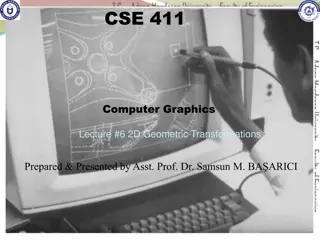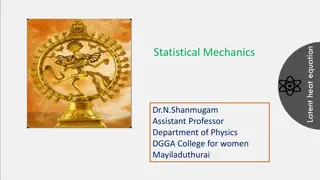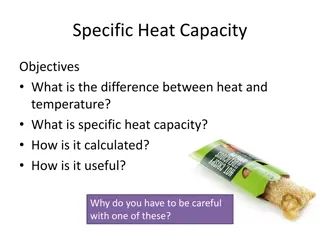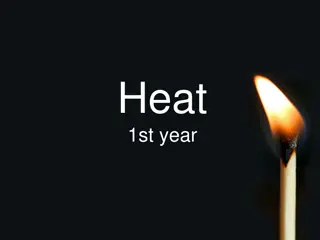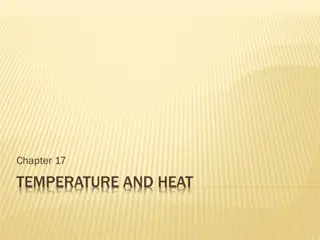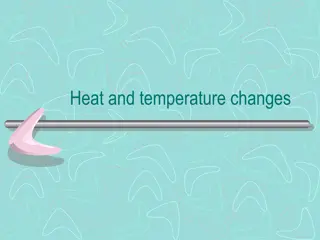Understanding Heat and Energy Transformations in Physics
Explore heat calculations, energy transformations, kinetic and potential energy concepts through illustrations of a bouncing ball and a pendulum. Learn to read specific heat tables and make temperature conversions. Dive into the world of thermal dynamics with practical examples and calculations in physics.
Download Presentation

Please find below an Image/Link to download the presentation.
The content on the website is provided AS IS for your information and personal use only. It may not be sold, licensed, or shared on other websites without obtaining consent from the author. Download presentation by click this link. If you encounter any issues during the download, it is possible that the publisher has removed the file from their server.
E N D
Presentation Transcript
Heat Calculations (pg 25 w/s) 1. 2. 3. 4. 5. 5000 J 21000 J 1840 J 0.21 cal/g C 10 C
Energy Transformations in Illustrations
Bouncing Ball When dropping a ball it travels the following path where is the Kinetic energy is decreasing Kinetic energy is increasing Kinetic energy is the HIGHEST Kinetic energy is the LOWEST Potential energy is decreasing Potential energy is increasing Potential energy is the HIGHEST Potential energy is the LOWEST Both KE and PE present
Pendulum A pendulum travels the following path where is the Kinetic energy is decreasing Kinetic energy is increasing Kinetic energy is the HIGHEST Kinetic energy is the LOWEST Potential energy is decreasing Potential energy is increasing Potential energy is the HIGHEST Potential energy is the LOWEST Both KE and PE present
Reading Specific Heat Tables Recall specific heat tells you how much energy is needed to increase the temperature of 1 gram by 1 degree. What substance takes the most energy to heat? What substance take the least energy to heat? What two substances listed make good conductors? What two substances make good insulators?
Temperature Conversation K = C+ 273 F = (9/5x C) +32 C = 5/9( F-32) Convert 58 C to K Convert 58 C to F Convert 358 K to C
K = C+ 273 F = (9/5x C) +32 Kinetic Energy =1/2 (mass x velocity2) KE = m v2 Potential Energy = mass x gravity x height PE = m g h g = 9.8 m/s2 Heat = mass x specific heat x change in temp Q = m c t C = 5/9( F-32)
Ch 15 22) PE=4312 J 23) KE=10J 24) V=9 m/s 25)KE=100 J 26)KE= 1960 J 27)KE= 2240 J 28) PE = 2058 J 29) PE = 3528 J Ch 16 43)Tf=58.86 C 44) c = 383.88 j/kgK 51) Q=47145 J 53)C = 272.5 J/kgK 54) Q=140.22 kJ








